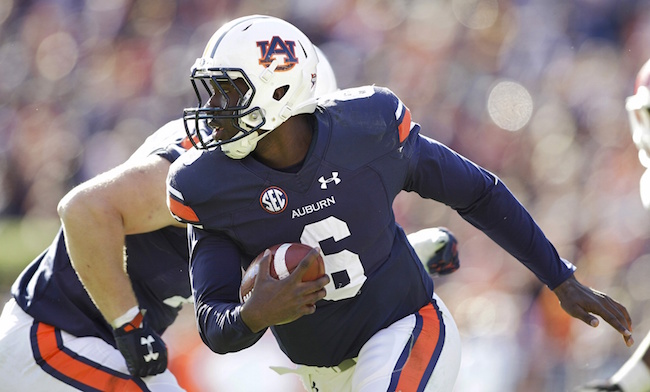
Any time you’re a major program that’s coming off a 7-6 season, there’s plenty of work to get done in the offseason. That’s certainly the case at Auburn.
Here are the biggest five areas where they need to improve:
1. Quarterback play: We’ve already discussed this week how Auburn’s top concern for next year will be to figure out who their quarterback is going to be. It’s the top priory, no question. Auburn is in desperate need of a quarterback that can execute, most likely one that can both move the ball through the air and on the ground. Jeremy Johnson and Sean White just weren’t good enough in 2015.
2. Receiver reliability: Auburn’s receivers in 2015 weren’t terrible, but they also weren’t fantastic. Both of the Tigers’ top receivers, Ricardo Louis and Melvin Ray, dropped too many passes, and many of the drops were drive-killers. They do have plenty of depth at the position, so there’s potential for a few guys to step up and become playmakers.
3. Defensive line: Other than quarterback, this was Auburn’s weakest area in 2015, ranking low in the SEC in almost every category. The Tigers’ rushing defense was the fourth-worst in the conference, allowing an average of 182.5 yards per game. Auburn ranked 13th out of 14 in sacks, with only 19 on the year. Auburn also tied with Kentucky for the fewest amount of tackles for a loss (53).
4. Secondary: There are concerns in Auburn’s secondary as well. In addition to the bad rushing totals, Auburn also had the fourth-worst pass defense in the conference in 2015, allowing an average of 222.6 yards per game. The Tigers also had one of the worst third-down conversion prevention rates in the SEC, allowing opponents to convert nearly 45 percent of the time. However, much like their receiver situation, the Tigers have plenty of young talent at the corners and safety. Someone can step up.
5. Third-down conversions: Once Gus Malzahn figured out the best way to implement his offense during the second half of 2015, Auburn was able to move the ball fairly successfully on first and second downs. However, when third down did creep up, the Tigers were not as successful. In ever Tigers loss, third-down conversion rates were a factor. Against Alabama, Auburn converted only three of 15 third downs. Against Georgia, Auburn converted four of 14. And against Ole Miss, Auburn converted two of 15. It’s an area that has to improve.
Christine Wang is a contributing writer for Saturday Down South. She covers Auburn, Arkansas and Ole Miss.







